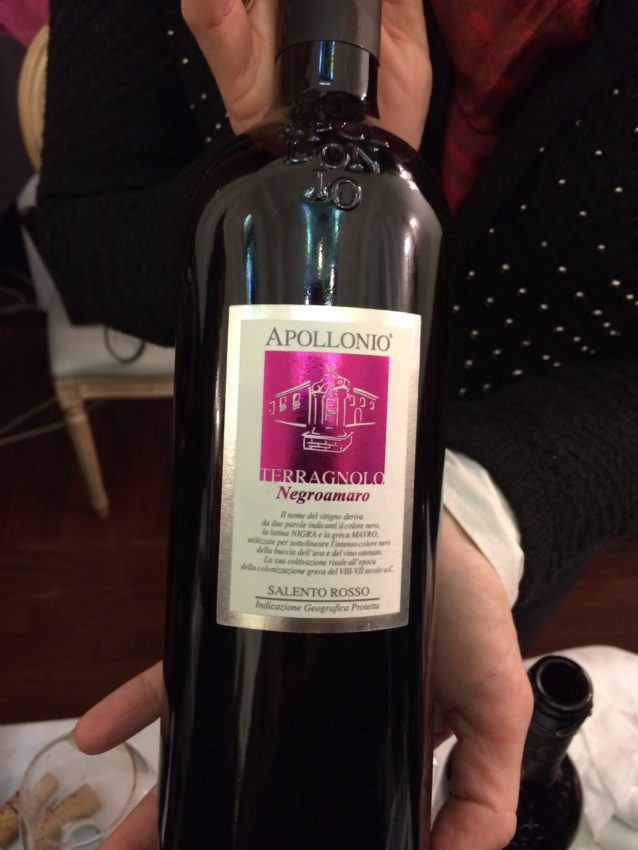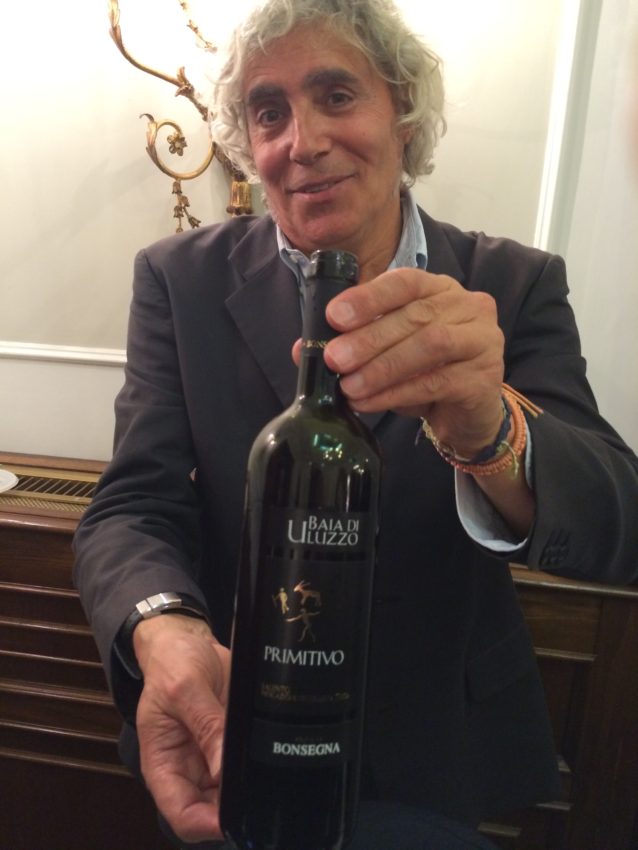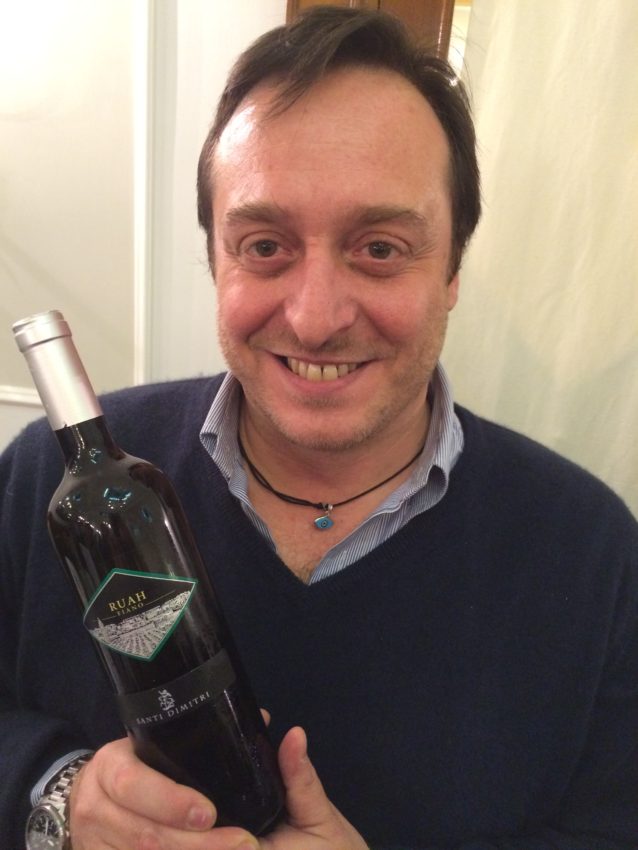Puglia wine tasting brings back memories of long coastlines and purple-red wines

I have so many pictures that have captured the beauty of Italy. The Christmas tree in front of the Colosseum. The canal in Venice as a fog settles in at dusk. A gym-junkie girlfriend in a Brazilian bikini in Sicily where …
… oops. Sorry. I got carried away. No, seriously, there is so much beauty in this country you must have a camera to capture it, just in case friends don’t believe your words that never quite do it justice. One of my favorite shots I took came during a travel writing assignment to Puglia, the heel of Italy’s boot. It was on the roof of my hotel in the romantic town of Vieste, sticking out into the Adriatic Sea on the far end of Parco Nazionale del Gargano, which forms a spur in the middle of the heel. The photo is a plate of local white cacioricotta cheese and a glass of purple-red Negroamaro wine.
It’s the perfect Pugliese lunch. Maybe it was looking out at the peaceful cobalt sea on a sunny spring day or seeing the old lighthouse sticking up in the sky like a thumb’s up on my life. Maybe it was the peace in discovering a region of Italy not overrun by tourists, let alone Americans. But Negroamaro wine — and Pugliese wine in general — have stuck in my mind ever since. I can find them all over Rome. One night last week I found many of the wines of Puglia all in one room.
Wine Tastings of Rome, a terrific Meetup group that could only have a more attractive name if Beyonce held its sign, brought in wine makers from around Puglia to one room at the Hotel Imperiale. Built in 1895, the Hotel Imperiale is as elegant as it sounds. It’s a gold palace with small balconies overlooking tree-lined Via Veneto, perhaps Rome’s most glamorous street where its rich and famous once preened for panting fans and fought with prying paparazzi. Walking into the snow-white interior, I felt thankful I wore a sportcoat as “retired journalist” and “elegant” aren’t usually found in the same sentence. The Hotel Imperiale makes you at least try to look the part.
Elegant isn’t a word usually associated with Puglia. Romantic. Sunny. Friendly. Yes. Very Italian? Absolutely. But Puglia is a sun-splashed rural wonderland where the perfect climate for agriculture and beach life meet along 480 miles of Adriatic coast. Pick olives in the morning; lay on a beach in the afternoon. Nearly half the olive oil in Italy is produced in Puglia. Today some of the world’s best wines are also.

They ushered me into a conference room ringed with tables and lit by chandeliers. I fell in love with the first wine I tried and fell further in love with each ensuing glass. I was like a sailor at the Playboy mansion. The first glass was a Negroamaro from Apollonio winery in the village of Monteroni di Lecce, near Lecce, Puglia’s palace-laden baroque city. It’s 50 percent Neroamaro and 50 percent Primitivo, Puglia’s most famous wines. You get the best of both worlds, the dark black berries of Neroamaro and the bright reds of Primitivo.

Next over I stepped up to a 100 percent Primitivo from the Vitivinicola Bonsegna Alessandro winery in Nardo, also near Lecce. Primitivo is Italy’s near equivalent to a California Zinfandel. Robust, fruity but kind of light, you can drink it with anything. The best part about it? This vintage retails for only 6.50 euros ($7.30). It was simply the best 6.50 wine of my life. Get a wine for that price in the U.S. and it’s served out of a box by a guy chewing tobacco.

Next to him was an 18-euro bottle of Primitivo from Vigneti Calitro in Sava, near Taranto, Puglia’s closest thing to an industrial city. I could tell the difference in price with one sip which helps illustrate what I love about Italian wines. It’s difficult to find bad wine in Italy, the kind that doubles you over the nearest toilet seat within three hours. The house wines in local restaurants are good. But pay a little extra and you really climb the ladder on your taste buds. You don’t need to know wine to know the difference.
The Pugliese made the world know the difference about 15 years ago. In the 20th century, Puglia was known for producing wines best served in bulk. They were mass-produced, high-alcoholic, gutless wines with little flavor but a price to match. At the turn of the century, a very small percentage of Pugliese wines earned the label of denominazione di origine (DOC), the government’s quality assurance label started in 1963. In 2010 it produced its first DOCG (level higher) label with a Primitivo di Manduria, a natural sweet wine.
Today, Primitivos are highly popular in California and wineries are becoming as popular destination stops in Puglia as the beaches and the romantic old towns.

One of the most interesting wines I had came from a family that first started growing grapes in Puglia in 1690. Carlo Vallone is the latest in a long line that goes back to when Puglia was part of the Byzantine Empire. His blue good luck nazar, found all over today’s Turkey (and over my front door in my old condo in Denver) to ward off bad luck, gave him more of a Middle Eastern look.
“My karma is wine,” he told me.
His Santi Dimitri winery in Galatina near Lecce produces a real solid Ruah wine made from a Fiano grape found predominantly in Campania around Naples.
As is my custom, I always ask people in the wine business one question: Pretend you’re going to be executed tomorrow morning. What’s the one bottle of wine in the world you drink tonight? Price is no obstacle. Here are some answers:
Alisa Popioppo, Appollonio: Barolo Cannubi
Natasha Dravkovic, Vigneti Calitro: Maisson Jacquesson champagne
Francesco Frisenda, Conti Zecca: Sassicaia Bolgheri.
Damiano Calo, Rosa del Golfo: Chateau O’Brien 1974


February 13, 2016 @ 3:38 am
Beautiful post.. the photos, the people, the wine
February 13, 2016 @ 11:28 am
Thanks, Pietra. Some things seem easy to write but it’s hard to find new superlatives about Puglia wine.
March 24, 2016 @ 11:15 am
Love your enthusiasm for these wines! Can’t wait to be down in that region soon, quaffing away!